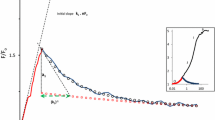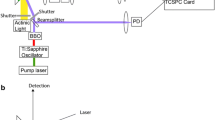Abstract
Non-photochemical chlorophyll fluorescence quenching (qN) in barley leaves has been analysed by monitoring its relaxation in the dark, by applying saturating pulses of light. At least three kinetically distinct phases to qN recovery are observed, which have previously been identified (Quick and Stitt 1989) as being due to high-energy state quenching (‘fast’), excitation energy redistribution due to a state transition (‘medium’) and photoinhibition (‘slow’). However, measurements of chlorophyll fluorescence at 77 K from leaf extracts show that state transitions only occur in low light conditions, whereas the ‘medium’ component of qN is very large in high light. The source of that part of the ‘medium’ component not accounted for by a state transition is discussed.
Similar content being viewed by others
Abbreviations
- ATP:
-
adenosine 5′-triphosphate
- DCMU:
-
3[3,4-dichlorophenyl]-1,1 dimethylurea
- ΔpH:
-
trans-thylakoid pH gradient
- Fo, Fm :
-
room-temperature chlorophyll fluorescence yield with all reaction centres open, closed
- Fv :
-
variable fluorescence = Fm−Fo
- LHC II:
-
Light harvesting complex II
- PS I, PS II:
-
Photosystem I, II
- P700, P680:
-
primary donor in photosystem I, II
- qP:
-
photochemical quenching of variable fluorescence
- qN:
-
non-photochemical quenching of variable fluorescence
- qNe, qNt, qNi :
-
non-photochemical quenching due to high energy state, state transition, photoinhibition
- qNf, qNm, qNs :
-
components of qN relaxing fast, medium, slow
- qr :
-
quenching of r relative to the dark state
- tricine:
-
N-tris[hydroxymethyl]methylglycine
- r:
-
ratio of fluorescence maximum from photosystem II to that from photosystem I at 77 K
References
AdamsIII WW, Demmig-Adams B and Winter K (1990) Relative contributions of zeaxanthin-related and zeaxanthin-unrelated types of ‘high-energy-state’ quenching of chlorophyll fluorescence in spinach leaves exposed to various environmental conditions. Plant Physiol 92: 302–309
Arnon DJ (1949) Copper enzymes in isolated chloroplasts. Plant Physiol 24: 1–15
Baker NR and Horton P (1987). Chlorophyll fluorescence quenching during photoinhibition. In: Kyle DJ, Osmond CB and Arntzen CJ (eds) Photoinhibition, pp 145–168. Amsterdam: Elsevier Science Publishers
Bradbury M and Baker NR (1984) A quantitative determination of photochemical and non-photochemical quenching during the slow phase of the chlorophyll fluorescence induction curve of bean leaves. Biochim Biophys Acta 765: 275–281
Bradbury M and Baker NR (1986) The kinetics of photoinhibition of the photosynthetic apparatus in pea chloroplasts. Plant Cell Environ 9: 289–297
Briantais J-M, Vernotte C, Picaud M and Krause GH (1979) A quantitative study of the slow decline of chlorophyll a fluorescence in isolated chloroplasts. Biochim Biophys Acta 548: 128–138
Canaani O, Barber J and Malkin S (1984) Evidence that phosphorylation and dephosphorylation regulate the distribution of excitation energy between the two photosystems of photosynthesis in vivo: photoacoustic and fluorimetric study of an intact leaf. Proc Natl Acad Sci USA 81: 1614–1618
Demmig B and Winter K (1988) Characterisation of three components of non-photochemical fluorescence quenching and their response to photoinhibition. Aust J Plant Physiol 15: 163–178
Demmig-Adams B, AdamsII WW, Heber U, Neimanis S, Winter K, Krueger A, Czygan F-C, Bilger W and Bjørkman O (1990) Inhibition of zeaxanthin formation and of rapid changes in radiationless energy dissipation by dithiothreitol in spinach leaves and chloroplasts. Plant Physiol 92: 293–301
Fernyhough P, Foyer CH and Horton P (1984) Increase in the level of thylakoid protein phosphorylation in maize mesophyll chloroplasts by decrease in the transthylakoid pH gradient. FEBS Letts 176: 133–138
Horton P (1989) Interactions between electron transport and carbon assimilation: regulation of light-harvesting and photochemistry. In: Briggs WR (ed) Plant Biology Vol 8: Photosynthesis, pp 393–406. New York: Alan R Liss Inc
Horton P and Black MT (1981) Light-dependent quenching of chlorophyll fluorescence in pea chloroplasts induced by adenosine 5′-triphosphate. Biochim Biophys Acta 623: 53–62
Horton P and Hague A (1988) Studies on the induction of chlorophyll fluorescence in isolated barley protoplasts. IV. Resolution of non-photochemical quenching. Biochim Biophys Acta 932: 107–115
Horton P, Lee P and Hague A (1987) Photoinhibition of isolated chloroplasts and protoplasts. In: Biggins J (ed) Progress in Photosynthesis Research, Vol IV, pp 59–62. Dordrecht: Martinus Nijhoff
Laasch H and Weis E (1989) Photosynthetic control, ‘energydependent’ quenching of chlorophyll fluorescence and photophosphorylation under influence of tertiary amines. Photosynth Res 22: 137–146
Lee CB, Rees D and Horton P (1990) Non-photochemical quenching of chlorophyll fluorescence in the green alga Dunaliella. Photosynth Res 24: 167–173
Metz JG, Nixon PJ, Roegner M, Brudvig GW and Diner BA (1989) Directed alteration of the D1 polypeptide of photosystem II: Evidence that tyrosine-161 is the redox component, Z, connecting the oxygen-evolving complex to the primary electron donor, P680. Biochemistry 28: 6960–6969
Noctor G, Rees D, Young A and Horton P (1991) The relationship between zeaxanthin, energy-dependent quenching of chlorophyll fluorescence, and trans-thylakoid pH gradient in isolated chloroplasts. Biochim Biophys Acta, in press
Ohad I, Adir N, Koike H, Kyle DJ and Inoue Y (1990) Mechanism of photoinhibition in vivo. A reversible lightinduced conformational change of reaction center II is related to an irreversible modification of the D1 protein. J Biol Chem 265: 1972–1979
Oxborough K, Lee P and Horton P (1987) Regulation of thylakoid protein phosphorylation by high-energy-state quenching. FEBS Letts 221: 211–214
Quick WP and Stitt M (1989) An examination of factors contributing to non-photochemical quenching of chlorophyll fluorescence in barley leaves. Biochim Biophys Acta 977: 287–296
Rees D, Young A, Noctor G, Britton G and Horton P (1989) Enhancement of the ΔpH-dependent dissipation of excitation energy in spinach chloroplasts by light-activation: correlation with the synthesis of zeaxanthin. FEBS Letts 256: 85–90
Weis E (1985) Chlorophyll fluorescence at 77 K in intact leaves: Characterization of a technique to eliminate artifacts related to self-absorption. Photosynth Res 6: 73–86
Williams WP and Allen JF (1987) State 1/State 2 changes in higher plants and algae. Photosynth Res 13: 19–45
Author information
Authors and Affiliations
Rights and permissions
About this article
Cite this article
Walters, R.G., Horton, P. Resolution of components of non-photochemical chlorophyll fluorescence quenching in barley leaves. Photosynth Res 27, 121–133 (1991). https://doi.org/10.1007/BF00033251
Received:
Accepted:
Issue Date:
DOI: https://doi.org/10.1007/BF00033251




